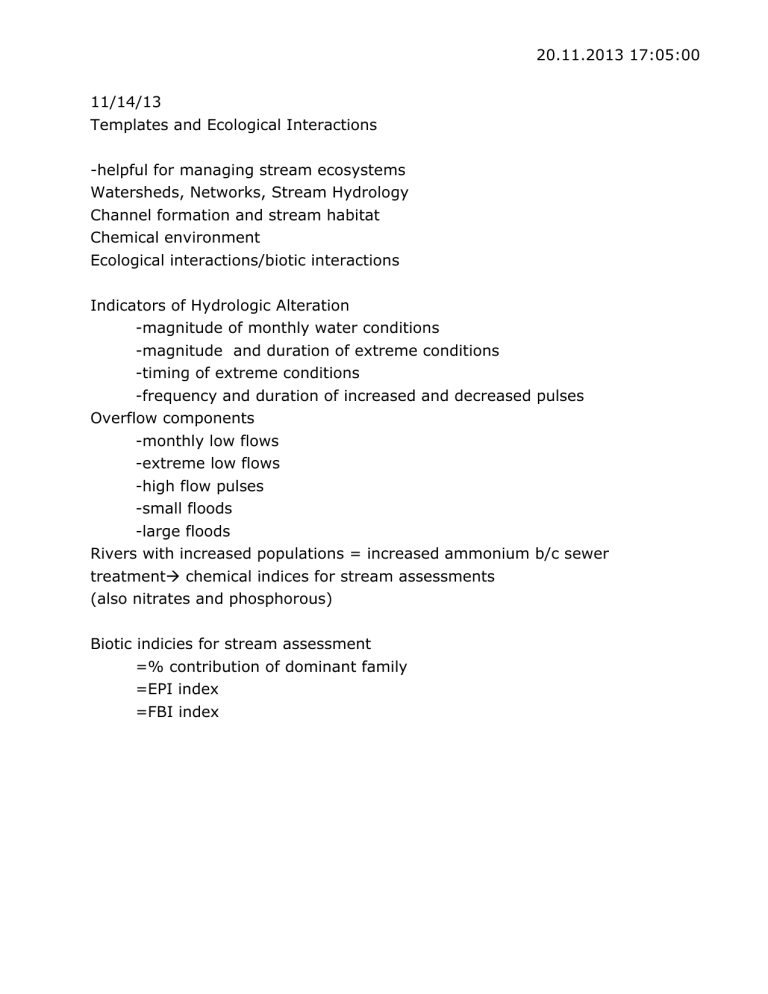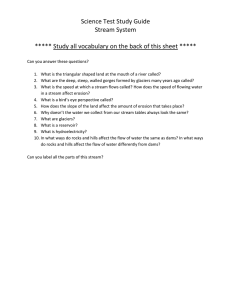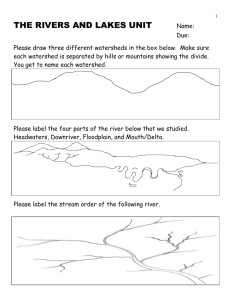
20.11.2013 17:05:00 11/14/13 Templates and Ecological Interactions -helpful for managing stream ecosystems Watersheds, Networks, Stream Hydrology Channel formation and stream habitat Chemical environment Ecological interactions/biotic interactions Indicators of Hydrologic Alteration -magnitude of monthly water conditions -magnitude and duration of extreme conditions -timing of extreme conditions -frequency and duration of increased and decreased pulses Overflow components -monthly low flows -extreme low flows -high flow pulses -small floods -large floods Rivers with increased populations = increased ammonium b/c sewer treatment chemical indices for stream assessments (also nitrates and phosphorous) Biotic indicies for stream assessment =% contribution of dominant family =EPI index =FBI index 20.11.2013 17:05:00 11/18/13 Nonindigenous species in fluvial environments Nonindigenous = not native in a particular area Four types: -localized and numerically rare -widespread but rare -localized but dominant -widespread and dominant ‘ecological imperialism’ (people recreate new landscapes, ex. Westward expansion, to be similar to where they came from, think their flora and fauna is better) Examples with rainbow/brown trout affecting stream dynamics (see slides) -Zebra mussels example -Saltceder tamarix -native vegetation contributes less to allochthonous inputs than saltceder River Fisheries 11/20/2013 5:05:00 PM What maintains productivity and biodiversity in rivers? Floodplain Rivers: Amazon River near Manaus High level of complexity o Low water: water in main channel, oxbow lakes, depression lake o High water: flat water across smaller channels Hudson River: Floodplain reduced o Backwater areas greatly reduced since 1907 Constrained river o Reduce size of channels in anthropogenic areas Mississippi River near St. Louis o Huge flood event in 1993 o Reclaimed floodplains Flood-Pulse Concept Annual predictable pulse (flood) is major control on riverine structure and function o Not the typical idea that production comes from upstream, predictable change as it moves downstream Lateral exchanges between floodplain and main river channel that gives nutrients Pulses result in alteration of flooding and drainage of floodplain (aquatic/terrestrial transition zone) Most primary production in floodplain rather than main channel o Input of sediments from floodwaters; nutrient release from newly flooded soil Spurs spawning o Large input of biomass of aquatic vegetation Young and adult fish disperse and feed, dissolved O2 permitting o Consolidation of sediments; moist soil germination Regrowth of terrestrial vegetation after water recedes Fish Reproduction in Floodplain Habitats: FPC flood pulse concept – alternative to river continuum concept (focuses more on the floodplain, disconnected from concept of movement of nutrients downstream) Temperal degree overlap between warm T and flood o Flood coming in in warm T in temperate environments o High PP in this time of year Predictability of flood o Fish need to be able to time to the flood pulse to spawn in the right time Rate of rise and fall o Slower is easier for fish to move with it Duration of inundation o Need a longer time of flood for fish to spawn and have a life history strategy Area of floodplain o Larger floodplain=more habitats available for fish Key Life History Attributes (fish population factors) Reproduction Growth o Need food sources and organic material Survival o What are the sources of mortality? Reproduction Small river spawning habitats: brook trout – North temperate habitat Use small rivers to spawn in reds Use upwelling ground water o Deposit in late fall, eggs covered by ice in winter Avoid predators during spawning season o Upwelling groundwater removes ammonia and waste and fungi accumulating on eggs o Provides constant T Vegetation associated spawning: pirate perch Spring spawner Attach eggs to tree roots and vegetative banks o Adhesive eggs o Hide eggs away from predators Channel catfish – South or tropics Spawn in cavity formed by rocks, logs, or a hole in a lake or river bank Growth Migrate to ocean or remain in coastal system? – Swedish stream How to accumulate enough E to grow large enough to allocate energy to reproduction? Life history challenge: get enough E to reproduce Fish in small steams need to decide to go to ocean or larger river system with more nutrients but more predation Migratory and resident populations in coastal streams: costs of migration Migratory brown trout pops found closer to coast and at lower altitude than year-round resident ones o Less energy to migrate if you’re closer to the ocean coast already o Less time in low energy environment o Migratory fish spend several years in ocean environment Recruitment of migratory brown trout pops declines at higher altitudes, but not resident ones o Migratory fish increase recruitment at locations Banded kokopu Strong altitudinal pattern at watershed scale Reflecting: o Migratory access o Habitat type – forest cover Migratory Life Cycles Diadromous: move between fresh and saltwater to complete lifecycle o Anadromous: sea fish that reproduce in freshwater (salmon) o Catadromous: freshwater fish that breed in the sea (eels) American Shad: Alosa sapidissima Shade CatchPerUE: Delaware River o Low catches per haul up until a spike in 1965 o Management to increase shad fisheries Reduction in fish harvest o o East o o o Then rise in 70s and 80s Fry stocking Improve fish passage Present decline from 90s Belief is that ocean conditions increased shad, not the actual river qualities coast American shad management Harvest regulations Fry stocking Fish passage enhancement o Recognition (through no management) of ocean condition influences Hypothesis: Physical stream environment determines ecological effect of salmon Lots of wood debris and forested area on one side of the stream channel Open and larger sediment in open watershed Gradient between heavy and light timber harvest o Retention of fish carcasses increases with large wood volume Retains nutrients of stream Before salmon migrate into stream channels, you have more PP (chlorophyll) in heavily harvested watershed (more nutrients from landscape and light) After salmon enter in fall, opposite effects (less PP in streams with heavily harvested watershed) because they are stirring up the sediment and decreasing light River Use and Dams 11/20/2013 5:05:00 PM Cautionary Fish Tale Colorado Pike o Really aggressive fish peopled liked to fish o Large fish by 1967 that they were endangered o Top predator that died o Changed river to use water American Experiment Population expansion in relation to hydro-geomorphic character of ricer basins encountered As population expanded west, encountered lots of rivers o Rivers used for mills and use In Ohio: Flood plains In arid parts west: irrigation Pacific NW: power Locks, levies, dams used to interact with water How much water does a river need? Varies Thinking about stuff that lives in rivers As variation increases, river health declines Simplified contrast Rivers want to change flow through time Humans want rivers to not change through time Dams and Demands Off land factors: fields, cities Most prominent in-channel mechanism for flow alteration Golden age of dams Many reasons to build dams, mostly recreation o Many small dams out there o Bigger dams used for hydropower, irrigation, flood control Effects can be dramatic o Before dam, Green River: driven by snowmelt Snows in winter, runs off in spring, low flow in summer o After dam: Far fewer flood peaks, higher flows in summer Make sure water is always available Disrupts millennia of evolution Dam Impacts General Findings: some consistency despite regional differences o High magnitude decreased o Low magnitude increased o Daily magnitude variance decreased o But reversals and pulse count increased o Timing expanded, seasoning is off Flow Homogenization Regional scale differences in 1st half of 20th century were reduced in dammed rivers but retained in undammed rivers Global Issue Info on 292 large river systems Are the systems modified? (Fragmentation and storage capacity) o Much of the world is red where people live o Outside of remote systems, not many unaltered major systems o Productivity is higher for rivers with infrastructure (dams) Reservoirs 16.5 million dams globally o 8000 cubic kilometers Latin America 47% projects are high impact Flow-Ecology Relations Effects biota through: o Habitat - space o Evolved life history patterns o Connectivity – movement place to place Riparian Flow Ecology (out of channel) Variety of different pathways from infrastructure to diversity reduced o Get down to loss of adapted species or change in succession (natural cycle) An Option Help organisms out o Blow up dams ELOHA Environmental Flows o Want infrastructure and productivity, but also want species to survive o Quantity and quality and timing of water needed to sustain aquatic ecosystems and services they contribute to human well-being In-between natural and regulated Blue box: river biology and dynamics Red box: what people who live in watershed want Green box: river science meets biology o Adaptive adjustments! Stream and River Restoration 11/20/2013 5:05:00 PM History Not until early 1970s that legislation or stream restoration really occured o Nepa, clean water act, endangered species act o Army corp undone under legislation More projects to restore streams than any other ecosystem besides maybe wetlands Functions people wanted from streams were taken away by army corp engineers, so lots of stream restoration Categories of fluvial modification Channelization o Flood control act straightened stream channels Levees o Disconnect stream channel from flood plain Dams o Retain water, reservoirs Removal of riparian vegetation o Common in agricultural areas Invasive species Impermeable surfaces in watershed Chemical discharge o Sewage treatment plants o Nutrient runoff Diversions o Smaller diversions from landform modification Pipes (streams going underground) Construction on floodplains Synthesis of US river restoration efforts 37000 river restoration projects reviewed most costly: land acquisition least costly: riparian management cumulative: 9.1 billion dollars o projects were not evaluated afterwards for success least expensive projects were most used Regional US river restoration efforts Upper Midwest: number of water quality and riparian management much reduced than other areas Pacific nw: very few bank stabilization projects because less of an agricultural region and highly erodible soils Terms Restoration: return to original undisturbed state o Use a temporal/historic or another stream to restore to that ideal o Few projects really try to fully restore streams Rehabilitation: restore or improve some aspects of a stream ecosystem Habitat enhancement: localized (eg fish structures) Reclamation: return a stream reach to its previous habitat type, but not restore all functions (eg levee removal) Mitigation: compensate elsewhere for adverse effects Common Rehabilitation Road rehabilitation o Redwood national park Park was to see if place could be restored o Recreate connectivity for fish o Rehabilitation meant removing road and restoring landscape and vegetation in high erodible soils Riparian Rehabilitation: silviculture o Restore vegetation o Remove invasives and reestablish vegetation due to grazing or human disturbance Fencing and Grazing o Fence out animals from grazing Floodplain rehab o Connecting isolated habitats o Levee breaching o Channel reconstruction o Creation of new floodplain habitat Removing berms o Channelizing/Restoring Kissimmee River Cost $414 million Dam removals o 1990s very few o 2000s more and more o downsides: nutrients or contaminants in sediments In stream habitat structures for fisheries enhancement Log structures Log jams (multiple logs) Cover structures Boulder structures Brush bundles In stream channel modification Rosgen The Future of Running Waters 11/20/2013 5:05:00 PM Identifying Key Drivers Humans are everywhere o There are not many pristine ecosystems that haven’t been impacted by human influence o Ecologists: How to manage and sustain systems Need to improve ecosystems Ambiguous metrics – not like human health with good metrics What do we need to do? Understand ecosystem drivers Understand large-scale patterns Understand long-term trends Understand ecosystem drivers Anthropogenic biomes – Erle Ellis Working in world with anthropogenic biomes, not classic biomes Humans control biodiversity and ecosystem processes as much as climate Classic biome maps do not represent state of environment o Much of biome area does not exist (potential vegetation) o Limited mention of urban and agriculture land use Classic climate based biomes are not static o Anthropogenic climate change is altering biome location and composition Biomes derived from global patterns of human interactions Key Drivers Exploitation of biological resources Land use modification Alteration of biogeochemical cycles Alteration of physical processes Human influences on the movement and distribution of living organisms Aggregation and accumulation of unique or rare compounds Are key drivers anthropogenic? Chart of % of sediment from cultivated land o Used cesium 137 tht was deposited on landscape from nuclear testing in 1950s and 60s o Sediments from clay glacier deposits have lower levels of Ce137 than sediments from agricultural lands Movement of Earth per Year – human driver Under natural conditions, most of earth moved by rivers is in west o Young mountains o Steep erodible landscapes o Not much in eastern US Current earth movement by mining, construction, etc o See the opposite of earth movement o Effects landscape greatly Hydrological Changes in Arizona – human driver Blue lines are natural rivers before development Turquoise lines: contour to parallel lines are canals o Now irrigation and ground water pumping o Summer time now has standing water and vegetation where ephemeral streams used to be Nitrogen cycling in urbanized desert ecosystem o Sycamore Creek (undisturbed): short flow paths in landscape, hyporheiic exchange, nitrogen cycling short o Indian bend wash (urbanized): Nitrogen cycling under control of humans: long flow paths – deep waters that are pumped back up Fertilizers, deep waters pumped up Understand large-scale patterns Compared forested to non forested stream reach across many stream orders Forested wider than unforested streams Unforested had higher water velocity Forested = rougher, more ammonium uptake, respiration, total macroinvertebrates Understand long-term trends Mississippi river sediment discharge Sediment discharge is currently correlated to water discharge In early decades, succeeded the water discharge Increased river alkalinization Upward trend in many eastern states Increase in elevation and precipitation had positive relationship with alkalinization What is a stream and why does it mater? Legislation Defining “waters of the US” is a matter of current political and constitutional debate





